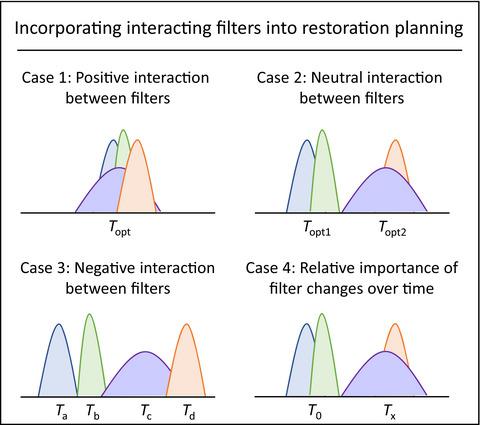Our official English website, www.x-mol.net, welcomes your
feedback! (Note: you will need to create a separate account there.)
Revising the trait-based filtering framework to include interacting filters: Lessons from grassland restoration
Journal of Ecology ( IF 5.3 ) Pub Date : 2021-08-12 , DOI: 10.1111/1365-2745.13763 Jennifer L. Funk 1
中文翻译:

修订基于特征的过滤框架以包括相互作用的过滤器:草地恢复的经验教训
更新日期:2021-10-11
Journal of Ecology ( IF 5.3 ) Pub Date : 2021-08-12 , DOI: 10.1111/1365-2745.13763 Jennifer L. Funk 1
Affiliation

|
- A trait-based framework of community assembly holds great promise for directing ecological restoration, both for selecting species with desirable traits and for manipulating community factors to enhance plant establishment and persistence. Dispersal, abiotic and biotic factors ‘filter’ species into local communities based on their traits, but interactions among these filters may complicate the use of trait-based assembly models. In this paper, I review recent studies that apply community-based theory to grassland restoration and propose a framework for incorporating interacting ecological filters into restoration design.
- Dispersal limits restoration success in many grassland communities while others are simultaneously limited by dispersal, environmental factors and biotic interactions. Furthermore, the relative importance of ecological filters can change over space and time. Species also differentially respond to filter manipulations which suggests that trait–environment relationships should be used to generate planting recommendations based on optimal trait values for interacting filters at a given site.
- Synthesis. A better understanding of how traits interact with dynamic community assembly filters will allow for site-specific management recommendations, resulting in restored communities that are resilient to a range of filter modifications including climate change, invasion by non-native species, and altered disturbance regimes.
中文翻译:

修订基于特征的过滤框架以包括相互作用的过滤器:草地恢复的经验教训
- 基于特性的群落组装框架在指导生态恢复方面具有广阔的前景,既可以选择具有理想特性的物种,也可以操纵群落因素以增强植物的建立和持久性。分散、非生物和生物因素根据物种的特征将物种“过滤”到当地社区,但这些过滤器之间的相互作用可能会使基于特征的组装模型的使用复杂化。在本文中,我回顾了最近将基于社区的理论应用于草地恢复的研究,并提出了一个将相互作用的生态过滤器纳入恢复设计的框架。
- 扩散限制了许多草原社区的恢复成功,而其他社区同时受到扩散、环境因素和生物相互作用的限制。此外,生态过滤器的相对重要性可以随空间和时间而变化。物种对过滤器操作的反应也不同,这表明应该使用性状-环境关系来根据给定地点相互作用过滤器的最佳性状值生成种植建议。
- 合成。更好地了解性状如何与动态群落组装过滤器相互作用将允许针对特定地点的管理建议,从而恢复社区,使其能够适应一系列过滤器修改,包括气候变化、非本地物种的入侵和改变的干扰机制。











































 京公网安备 11010802027423号
京公网安备 11010802027423号